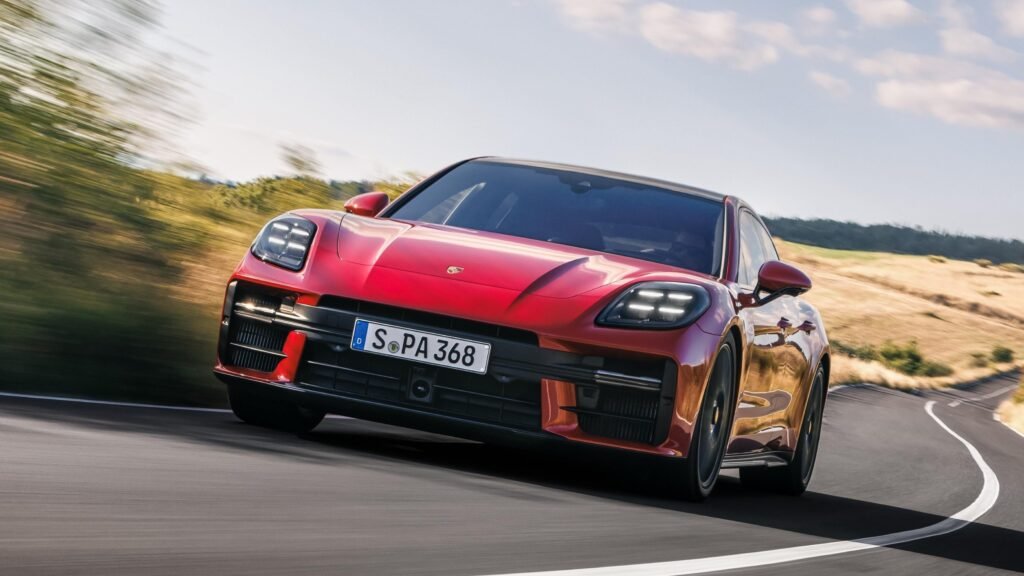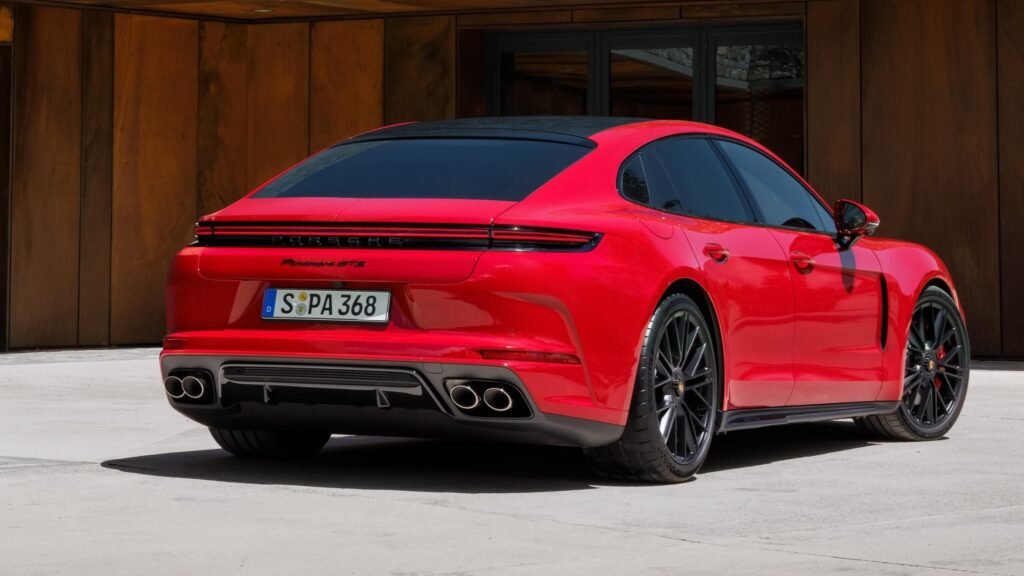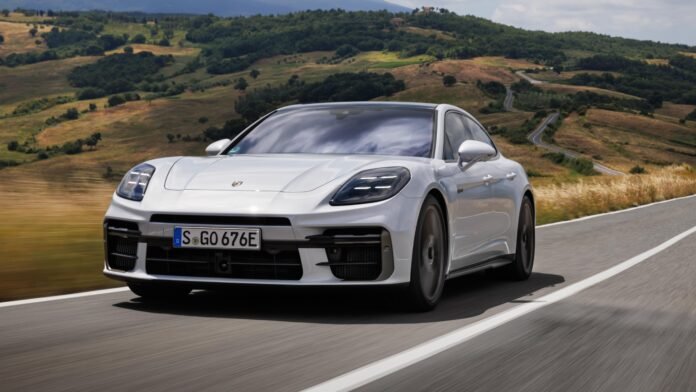Porsche has unveiled the new dynamic top series models with the Panamera Turbo S E-Hybrid and the Panamera GTS. The two particularly powerful and sporty variants added to the model range are cars with different focuses. While, the Panamera GTS is a dynamic sports saloon that places the emotional driving experience in the foreground, the Panamera Turbo S E-Hybrid is positioned at the very top of the model series as the most powerful, fastest and most luxurious derivative.
Porsche Panamera Turbo S E-Hybrid
The New Porsche Panamera Turbo S E-Hybrid is the most powerful Panamera produced in its series so far. The 4-litre biturbo V8 engine churns out 599 hp (441 kW) of power and 1000 Nm of torque. Thanks to the new electric motor which further added an output of 102 hp and 150 Nm of torque than its predecessor. The Porsche Panamera Turbo S E-Hybrid is powered by Euro 7 compliant 4-litre biturbo V8 engine. The Euro 7 compliant mated to a 8-speed Porsche dual clutch transmission (PDK). The Panamera Turbo S E-Hybrid accelerates from zero to 100 km/h in 2.9 seconds and has a top speed of 325 km/h. This signifies an enhancement of 25 km/h and 0.5 seconds.

Compared to the previous generation, its hybrid powertrain offers better electric range and faster charging options. With a capacity of 25.9 kWh (gross), the high voltage battery stores 45 per cent more energy than the predecessor battery did. This gives the most powerful Panamera an electric range of up to 88 km (WLTP EAER City). At a suitable power source, the 11 kW on-board AC charger charges the battery from zero to 100 per cent in around two hours and 39 minutes.

Porsche underlines the role of the Turbo models as the top performers in their model lines with a distinctive rear bumper and a distinctive front end in the exterior colour. At the rear, the chrome-plated tailpipes in Dark Bronze complete this look. The standard equipment for the Turbo S E-Hybrid also includes the Porsche Ceramic Composite Brake (PCCB) with yellow brake callipers. Acid Green is also available as a typical E-Hybrid colour.

Turbonite, the elegant metallic grey tone, is exclusively reserved for the Turbo models. The Panamera Turbo S E-Hybrid has this colour on its airblades at the front of the car, on the strip of its rear bumper, and on the forged 21-inch Panamera Turbo S centre-lock wheels. Porsche also uses Turbonite in the interior, for example on the trim strips and belt straps, the controls in the centre console, and the steering wheel. Turbonite contrast stitching also features on the seats, door panel trim, dashboard and floor mats. The roof lining is completely upholstered with the suede-like Race-Tex.
Nürburgring Nordschleife’s fastest top-class saloon

Ahead of its launch, Porsche Panamera Turbo S E-Hybrid set the record for the fastest top-class saloon with a combustion and hybrid engine in the official ranking of Nürburgring 1927 GmbH & Co. KG on 12 July 2024. Porsche test driver Lars Kern (36) completed the record lap at the Nürburgring Nordschleife (20.832 kilometres) in just 7:24.172 minutes.
With this new class record, the new Panamera sports a new Carbon Aerokit, which is available for the sports saloon models of the Panamera Turbo and the Turbo S E-Hybrid. It includes airblades, side skirts and a rear diffuser made of carbon, and optimises the aerodynamic balance for driving on the racetrack. The front spoiler lip completely eliminates lift on the front axle. In combination with the Gurney flap on the adaptive 4-way rear spoiler, its net effect is to generate downforce.
At a speed of 200 km/h, it improves the downforce by 60 kg and enables cornering at even higher speeds. The new Porsche Panamera Turbo S E-Hybrid runs on Michelin Pilot Sport Cup 2 tyres with dimensions 275/35 ZR 21 at the front and 325/30 ZR 21 at the rear, which are specially developed for the Panamera.

The top model of the new Panamera series comes equipped with the Porsche Active Ride suspension as standard. This innovative chassis is coupled with a 400 V high-voltage system and is therefore technically feasible only in the Panamera models with an E-Hybrid drive. Each shock absorber has an electrically operated hydraulic pump that actively generates forces in the rebound or compression direction.
In this way, the suspension almost fully compensates body movements and keeps the car horizontal during dynamic driving manoeuvres. The technology enables innovative functions such as the overcompensation of pitching and rolling motions. It also matches the wheel load distribution to the grip level, thereby optimising the traction.
The comprehensive range of equipment available for the Panamera Turbo S E-Hybrid also includes all the driving dynamics control systems, rear-axle steering, the Porsche Ceramic Composite Brake (PCCB) with 440 mm brake discs at the front and a 380 mm diameter at the rear, as well as a Bose sound system.
Porsche Panamera GTS

GTS stands for Gran Turismo Sport. Porsche cars with this model designation offer an extra serving of sportiness and maximum driving pleasure, together with high day-to-day usability. In line with this philosophy, the Panamera GTS is also distinguished by a chassis tuned for high performance, an exclusive SportDesign package and a sporty, high-quality interior. It is a particularly direct and agile variant of the top-class sports saloon. The powerful, comprehensively upgraded V8 biturbo engine plays a major role in the especially intensive driving experience in the Panamera GTS. It offers linear power delivery that is clearly noticeable even at engine speeds above 6,000 rpm.
The new Porsche Panamera GTS is powered by the same 4-litre biturbo V8 engine, which produces 500 PS (368 kW) of power and 660 Nm of torque. The new Panamera GTS accelerates from 0-100 km/h in 3.8 seconds and has a top speed of 302 km/h. The standard sports exhaust system in the Panamera GTS is specifically developed to create a powerful, emotional soundscape.

Porsche has given the standard dual-chamber two-valve air suspension including PASM in the Panamera GTS a particularly sporty tuning. The 10mm-lower body and reinforced anti-roll bars provide a noticeably more direct driving experience and a lower basic spring rate. The electronically controlled PTV Plus differential lock ensures the torque is distributed optimally between the wheels. In combination, these measures ensure greater body stability and reduced pitching and rolling over the entire speed range. These added dynamics come without any significant reduction in comfort.

As is the case across all model lines, the Porsche GTS models can be identified by their distinctive sporty design. Black GTS logos on the sides and rear of the car, a unique front section, dark-tinted HD matrix LED headlights and tail lights, as well as red brake callipers also make the Panamera GTS unmistakable. The standard Sport package also includes body trim elements in satin-matt Black. These include side skirts, insets in the front area, side window trim, and the rear bumper. Porsche has kept the tailpipes of the sports exhaust system in Dark Bronze to create an exciting contrast. A further accent is added by the 21-inch Turbo S centre-lock wheels in Anthracite Grey.

Inside, 2025 Porsche Panamera GTS is dominated by the use of the suede-like Race-Tex. It covers the roof lining, armrests and door panels, as well as the centre panels of the adaptive sports seats with 18-way adjustment. Porsche also offers two GTS-specific interior packages in Carmine Red or Slate Grey Neo. The decorative stitching and belts also come in the colour of the selected package. An interior package in Carbon matt is also available. The standard equipment of the Panamera GTS also includes a Bose sound system and the Sport Chrono package with a stopwatch and the push-to-pass function.
Market launch
The new Porsche Panamera Turbo S E-Hybrid and the Panamera GTS are now available to order as sports saloons. The Executive variant of the Panamera Turbo S E-Hybrid with a long wheelbase is offered on a market-specific basis. The Panamera GTS comes exclusively as a sports saloon with a short wheelbase. Deliveries in Germany will begin in autumn 2024.


